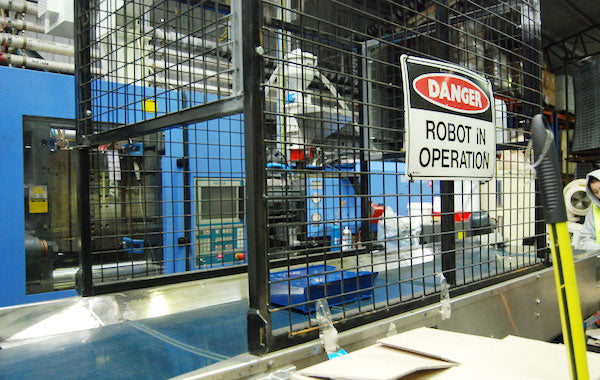“One of the biggest challenges for the Australian manufacturing sector is the cost of labour. In short, labour costs in Australia are much higher than many of the countries which we compete against in the plastic injection moulding industry,” says A Plus Plastics’ Managing Director Matt Holloway.
“When I started in my role at A Plus in the early noughties, we had very little automation, and while that worked back in the 80s and 90s, it definitely isn’t sustainable in the 21st Century,” he added.
A Plus Plastics has embraced automation and has invested in a fleet of robots for its production line, including six 3-axis robots and four 6-axis robots that are effectively making the manufacturing cells far more automatic.
Plastic injection moulders around the world
Automation has become a key tool for injection moulders all around the world when looking to maximise their capacity and productivity while keeping overheads manageable. Price competition is fierce amongst injection moulders, particularly those operating in Asia, where the cost of labour is considerably lower.
In order to remain in business, it’s important for injection moulders to maximise their margins, and automation has proven to be one of the most effective ways of doing this.
The role of robots
For many years, automation has played a key role in the most repetitive and rote parts of the injection moulding process: removing ejected parts from the mould, picking and placing pieces on conveyor belts or other conduits to the next step in the process, and so on. This type of automation is extremely useful for speeding up repetitive processes. It also has the added benefit of removing the more repetitive and boring tasks from A Plus workers.
A wide range of robots with varying capabilities can be used for automation on injection moulding machines. 3-axis robots are used for horizontal plastic injection moulding machines and high-speed processes, whereas 6-axis robots are flexible in both horizontal and vertical injection moulding machines, allowing a larger work envelope.
One of the main types of secondary robotic injection moulding is insert loading. Within the cycle time, robots can insert metal or plastic parts into the machine for the moulding process. They can then unload the machine, take the moulded part and insert it into another machine for the over-moulding process.
During the over-moulding process, two materials are merged to form one cohesive component. Not only can the robot remove the part from the injection moulding machine, but it can perform secondary applications as well. For example, while the injection moulding machine is working, the robot can take advantage of its valuable free time by performing trimming, de-gating, or other secondary processes. This leads to further increases in efficiency and output.
The future of injection moulding
The future of injection moulding will certainly involve increased use of automation, but it will also always involve people as well. Neither are going anywhere in the increasingly competitive market.
“While robots are really important for making our processes more efficient at A Plus Plastics, we still need people. We cannot run our facility with robots alone. They are very much a support technology to our people. We also understand our obligations to the Australian manufacturing sector and know that human labour is a key part of that,” says Matt.
Looking ahead to 2020 and beyond, Matt remains positive regarding the future of the plastic injection moulding industry in Australia.
“It remains the best way to produce many components, driving advances in distribution, warehousing, consumer technology, medicine, defence equipment and beyond,” he opines.
“The ability of an injection moulding facility to meet requirements for those applications and industries will, in many cases, play a major role in their success or failure. In-house automation or contract manufacturers with extensive automation capabilities will be necessary tools for almost all manufacturers and entrepreneurs.”
Want more?
Watch our robot technology in progress creating our GEOHEX™ Erosion Control System in our factory in Sydney’s southwest: http://bit.ly/35S91RT


